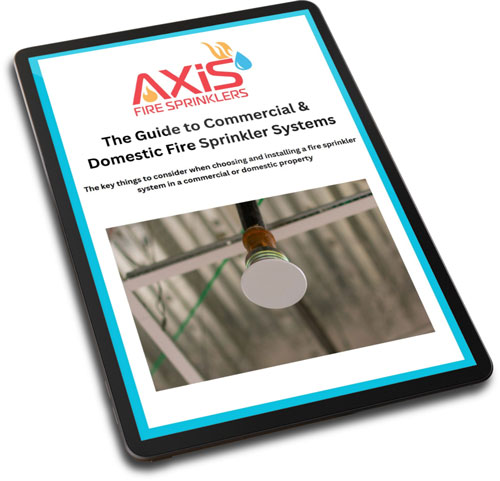Essential Home Fire Safety Tips To Protect Your Sanctuary
Every homeowner’s worst nightmare is a sudden, catastrophic fire with immediate and long-term effects. Not only do fires cause immediate destruction, ripping apart your home in a flash, but there is also a severe risk of more substantial losses – loss of your home, all the cherished memories it holds and, most vitally, the lives within.
This is why home fire safety is crucial, yet it can often be neglected. At Axis Fire Sprinklers, we understand the crucial role home fire safety plays in protecting your home, possessions and family and offer an array of fire sprinklers across the South of England.
In this guide, we are sharing the three most important home fire safety tips to take to protect your home and ensure your loved ones’ well-being well into the future.
Understanding the Importance of Home Fire Safety
Home fire safety is vital to safeguarding your home, possessions and loved ones – yet many people disregard it.
Despite the significant threats that fires can pose to your home and the lives within, many think this simply won’t happen to them, which is why they may be tempted to leave things unattended.
Instead, many homeowners are concerned about protecting their assets from theft and damage, investing in home security and even insurance ahead of home fire safety. While home security is essential, home fire safety is too and needs just as much attention.
Fires can cause unprecedented damage to your home, as well as endangering the lives of your loved ones. Implementing a robust fire safety plan can curtail these risks and ensure swift action during an emergency, preserving the health and safety of your family during the worst-case scenarios.
A fire safety plan can be implemented through three crucial steps, allowing you to prevent fires while guaranteeing a secure evacuation in the worst-case scenario.
Step 1: Install and Maintain Smoke Prevention Systems
The first step in safeguarding your home from fire is to install smoke alarms and fire sprinklers. Smoke alarms are your frontline defence, as they provide early warnings that can save lives, whereas fire sprinklers can help tame the flames to minimise property damage.
As fire safety experts, we can share that homes with working smoke alarms have a considerably lower risk of fire-related fatalities.
Smoke alarms should be paired with fire sprinklers to provide additional protection, ensuring that you are not only altered to any fire hazards but there is also prevention taking place as well.
At Axis Fire Sprinklers, we offer a wide range of commercial and residential fire sprinklers across the UK. We can work with you to provide the best fire sprinkler system for your requirements, as well as help maintain and repair any issues you may face.
Step 2: Design and Practice a Fire Escape Plan
Installing smoke alarms throughout your home is the initial step towards enhancing home fire safety, but what happens when they’re triggered?
Ensuring that everyone knows how to act during a fire emergency is the key to protecting lives. This is why developing a cogently structured fire escape plan is crucial.
A fire escape plan outlines the steps you and your family need to take to evacuate your home safely during a fire, taking your fire safety to an entirely new level.
How To Plan Your Fire Escape
When devising your fire escape plan, you first need to identify two exits from every room in your home that can be used during fires. These exits can be doors or windows, as long as they facilitate a quick escape outside.
For these exits to be effective, you need to ensure that all windows can be effortlessly opened if needed, and are not obstructed by furniture or security bars. If you live in a multi-storey home, consider investing in escape ladders for the upper floors to allow for a swift evacuation during emergencies.
To identify the best exits for each room, take some time to sketch out your home’s layout. On this blueprint, you can mark all potential escape routes and exits, giving you a focus during emergencies as well as helping to identify which areas need improvements for better home fire safety.
Once you’ve highlighted the fire exits and safest routes from each room in the house, designate a safe meeting place outside of your home. This meeting place should be a safe distance from your home and accessible to all.
If each family member is escaping separately, you need a place where you can all gather after evacuation to ensure everyone’s well-being.
Practising Your Fire Escape Plan
Designing the plan is the first step – it’s also crucial to involve the family so everyone understands what to do during an emergency. It’s recommended to rehearse your fire escape plan regularly to ensure everyone knows what to do during the worst-case scenario to ensure home fire safety.
All household members need to be present and participate in this rehearsal. Regular fire drills are a great way to ensure that everyone understands how to act, ensuring they can perform a calm and swift evacuation when necessary.
Fire drills should be conducted at least twice a year at different times of the day to practise evacuating from different rooms using the varied escape routes you have set up.
For homes with children, each child should be taught how to escape on their own in case you are unable to assist them during an emergency.
During these fire drills, reinforce the importance of staying low to the ground to avoid smoke inhalation and the practice of feeling doors for heat before opening them. If a door is hot, instruct everyone to use an alternative exit, highlighting these in your plan and fire drills.
This constant reminder can facilitate a safe evacuation should the situation arise and reduce the risk to life by fostering an environment of home fire safety.
Commit to becoming familiar with your fire escape plan and get everyone involved so they know what to do in the case of a real emergency. With practice, you can diminish panic and confusion during actual emergencies and increase the likelihood of safe evacuations for everyone present.
Step 3: Adopt Fire Prevention Measures
While it’s beneficial to rehearse how to act during a fire emergency, prevention is the best weapon you can have for home fire safety. Preventing fires from happening, or from spreading if they occur, in the first place is the most effective way to protect your home and family.
Implementing fire prevention measures can substantially reduce the risk of a fire occurring in your home and there are several ways you can do this across your property.
Kitchen Fire Safety
The kitchen is the most common area for home fires to start and therefore needs particular attention to enhance fire safety in the kitchen.
Common sense can be a powerful tool for fire prevention, such as always staying in the kitchen when cooking – especially when using the stove. Also, keep flammable items, such as kitchen towels and paper products, away from the stove to prevent them from igniting.
After you’ve finished in the kitchen, take a moment to ensure that all cooking appliances are turned off. It’s also a good idea to install a fire extinguisher or fire sprinklers in the kitchen, as catching a fire early can avert a more significant issue.
Home Fire Safety For Electricals
Defective electrical systems are a leading cause of home fires and can be extremely hazardous.
This is why you need to regularly inspect your home’s electrical wiring as well as any outlets and appliances. During these inspections, check all of these for signs of wear or damage, and if you do notice this, ensure you seek professional electricians to repair or replace them.
Additionally, avoid overloading electrical outlets. Surge protectors can be a great tool to avert damage if you have a shortage of outlets or particularly high electrical use areas.
Get into the habit of unplugging any appliance that is not in use and try to avoid using extension cords as permanent solutions, as they are prone to overheating.
If you notice any issues or are concerned about electrical hazards in your home, hire a licensed electrician immediately.
Heating Fire Safety
During colder months, heating equipment like space heaters, fireplaces, and radiators can become potential fire hazards if not properly maintained.
It is essential to ensure that all heating devices are regularly inspected and serviced according to the manufacturer’s recommendations for better home fire safety. Maintain a safe distance between heating equipment and any flammable materials, such as furniture, bedding, and curtains.
Additionally, use space heaters with automatic shut-off features, which can significantly reduce the risk of fires if the unit tips over or overheats.
Proper chimney cleaning is also crucial for those using fireplaces. Schedule annual inspections to remove any creosote buildup, which can ignite if not addressed.
Finally, consider investing in carbon monoxide detectors near sleeping areas to further protect your family from potential dangers associated with heating systems.
Smoking Safely
If you’re a smoker, do it outdoors, and use a robust, deep ashtray to contain all the ash and cigarette remains securely.
Avoid smoking in bed or when you’re feeling sleepy, as it’s easy to lose grip of the cigarette and initiate a fire.
Once you’re done smoking, ensure cigarette leftovers are thoroughly put out before you discard them. Regardless of whether you smoke or not, it’s worth considering a no-smoking policy indoors to further diminish fire dangers by obliging smokers to step outside, fostering an environment of home fire safety.
General Home Fire Safety
There are several other methods to lower fire risks around the home, regardless of the room or activity. Many of these home fire safety tips are based on plain common sense and can be highly effective.
For instance, keeping matches and lighters away from children’s reach; storing inflammable liquids like gasoline and paint thinners in sanctioned containers away from heat sources; and using fire-resistant materials like fire-retardant curtains and rugs can majorly protect your home, property, and loved ones.
Along with these steps to minimise fire dangers and enhance home fire safety is maintaining open dialogue about home fire safety with your family and home residents. Invest time in educating everyone about the fire safety practices you’re implementing and encourage them to identify potential hazards.
Axis Fire Sprinklers: Your Partner In Home Fire Safety
At Axis Fire Sprinklers, we’re committed to helping you safeguard your home from fire. With over 10 years of expertise in fire sprinkler installation and operate across the South of England to protect homes and businesses from major risks.
Fire is a significant threat in homes and can cause considerable loss to both your home and the items within, and potentially life. It’s crucial to play an active part in protecting your home from fire and implement the three steps to fire safety, as outlined in this guide.
While there’s a lot you can handle yourself to protect your home, parts like inspections, fire sprinkler installations, and maintenance might need professional aid. Our proficient team is here to provide you with the optimal fire safety solutions for your requirements.
Contact Us Today
We offer fire sprinkler installation for commercial and residential properties in the South of England. If you have any queries or need more help, don’t hesitate to contact us.


